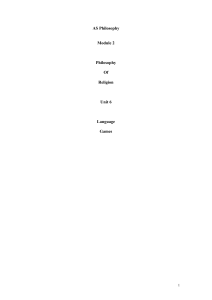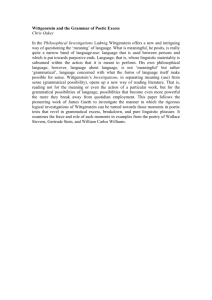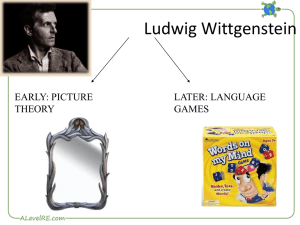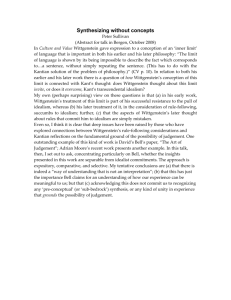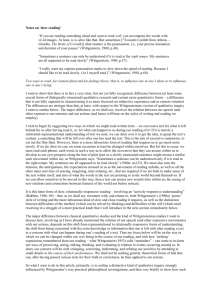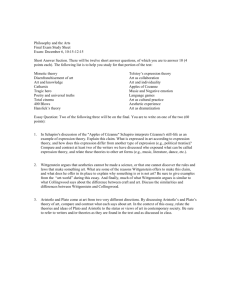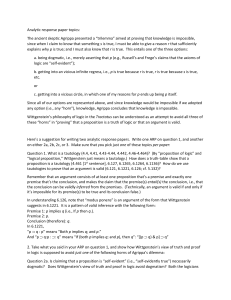Some notes on Wittgenstein - sections 1-75
advertisement
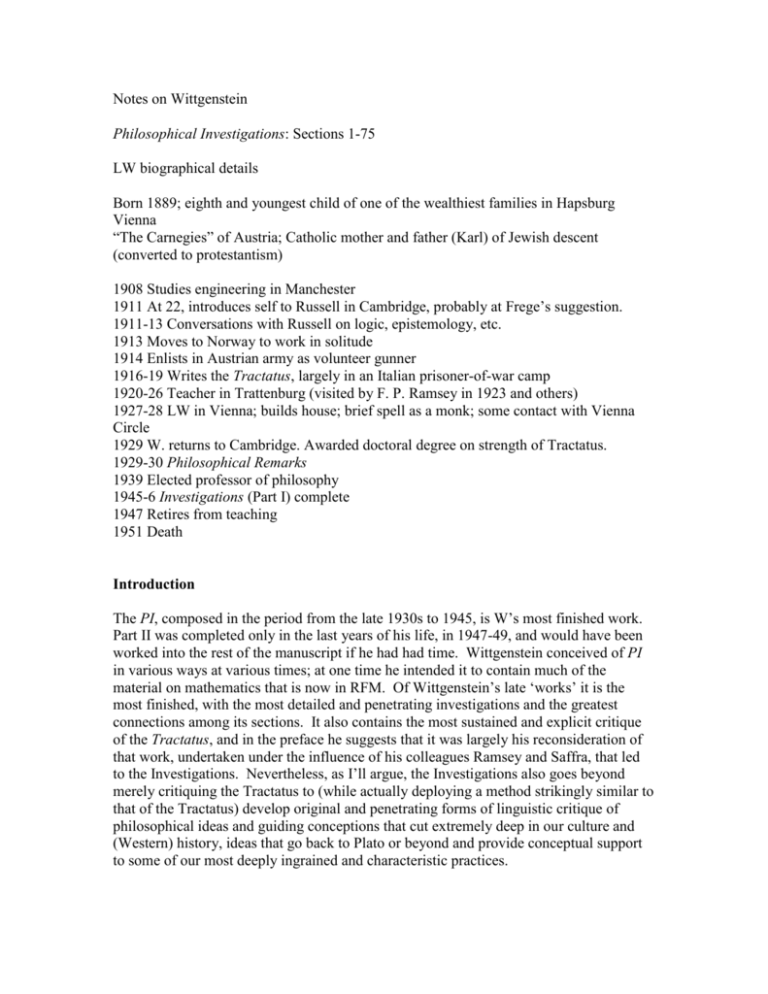
Notes on Wittgenstein Philosophical Investigations: Sections 1-75 LW biographical details Born 1889; eighth and youngest child of one of the wealthiest families in Hapsburg Vienna “The Carnegies” of Austria; Catholic mother and father (Karl) of Jewish descent (converted to protestantism) 1908 Studies engineering in Manchester 1911 At 22, introduces self to Russell in Cambridge, probably at Frege’s suggestion. 1911-13 Conversations with Russell on logic, epistemology, etc. 1913 Moves to Norway to work in solitude 1914 Enlists in Austrian army as volunteer gunner 1916-19 Writes the Tractatus, largely in an Italian prisoner-of-war camp 1920-26 Teacher in Trattenburg (visited by F. P. Ramsey in 1923 and others) 1927-28 LW in Vienna; builds house; brief spell as a monk; some contact with Vienna Circle 1929 W. returns to Cambridge. Awarded doctoral degree on strength of Tractatus. 1929-30 Philosophical Remarks 1939 Elected professor of philosophy 1945-6 Investigations (Part I) complete 1947 Retires from teaching 1951 Death Introduction The PI, composed in the period from the late 1930s to 1945, is W’s most finished work. Part II was completed only in the last years of his life, in 1947-49, and would have been worked into the rest of the manuscript if he had had time. Wittgenstein conceived of PI in various ways at various times; at one time he intended it to contain much of the material on mathematics that is now in RFM. Of Wittgenstein’s late ‘works’ it is the most finished, with the most detailed and penetrating investigations and the greatest connections among its sections. It also contains the most sustained and explicit critique of the Tractatus, and in the preface he suggests that it was largely his reconsideration of that work, undertaken under the influence of his colleagues Ramsey and Saffra, that led to the Investigations. Nevertheless, as I’ll argue, the Investigations also goes beyond merely critiquing the Tractatus to (while actually deploying a method strikingly similar to that of the Tractatus) develop original and penetrating forms of linguistic critique of philosophical ideas and guiding conceptions that cut extremely deep in our culture and (Western) history, ideas that go back to Plato or beyond and provide conceptual support to some of our most deeply ingrained and characteristic practices. In interpreting the Investigations, I’ll be opposing roughly two lines of more or less prevalant interpretation. As we saw in reading the Tractatus, it is a mistake to read that work as containing an unproblematic “theory” of language or of the world because of the way that the drive to philosophical theory is itself supposed to be dialecticized and partially cured by the practice of the book. I think that it’s wrong, for similar reasons, to read the Investigations as containing any theory of language or of the “social practices” that are said to underlie it. The interpretation of the book’s special terms of art (“language games”; “forms of life”) as theoretical terms meant to do service to an account of language and social practice makes completely mysterious the book’s particular dialectical style of writing. But it it still tempting to take him up in this way (thus we have books like “Wittgenstein: A social theory of knowledge”), and people like Habermas will quite unreflectively refer to “Wittgenstein’s account of rules” etc. As we’ll see, this also flies in the face of the book’s own description of its method as a kind of “therapy,” not the introduction of philosophical theories but the curing of the disease that philosophy is. This brings me to the second interpretation I’ll also oppose. Once we see that Wittgenstein isn’t offering a philosophical theory, and we see that his aim is instead a kind of therapy, we can be tempted to think that his aim is simply deflationary: to show that there is no point in doing philosophy, and to get us to stop. Thus, it can seem that he wants to show that philosophy is “just another language game”; that it is simply a contingent practice; that it is no better than any other practice; that it deserves no special dignity. This – what I’ll call the “end of philosophy” interpretation (following Rorty) – seems to me to miss one distinctive element of Wittgenstein’s method, that we already saw in the Tractatus: that it is decisively and constitutively engaged with the philosophical problems it aims to cure. There is no curing these problems – what Wittgenstein, I think, would have thought of as the deepest and most important ones – without fully engaging with our drives to philosophy; and there is no general or comprehensive way of curing ourselves of them. If Wittgenstein’s aim is sometimes to show us the contingency of our practices, it is also (and just as often) to show us their necessity, the unavoidability for us of the facts that we speak, question, understand, interrogate; and the problems that define the history of philosophy are just so many reactions to, interpretations of, these unavoidable facts. Wittgenstein’s teachings are, I want to argue, as deep as these necessities themselves; and the only way to produce out of them an argument that philosophy is at its end is to do something that Wittgenstein himself never would: namely to take the deepest necessities of our lives to be mere contingencies, amenable to scientific explanation and understanding. Structure of the text (roughly): 1-42. The “Augustinian Picture” of language. The variety of uses of language. 43-65. Initial critique of the Tractatus: “Names stand for simples.” 66-81. “Family resemblance” and games. 82-88. Rule-following (“Prelude”) 89-142. Philosophy 143-203. The “rule-following considerations” I 204-242. Rule-following considerations II 243- c. 300. “Private Language Argument” Part II. “Philosophy of Psychology”. Intentionality and “aspect-perception” The Structure of the Book: We notice right away how different the writing of this book is from the Tractatus. Instead of crisply numbered sections, heirarchically organized, we now get longish paragraphs, variously organized, including quotes and interruptions, progressing sometimes toward one apparent goal, sometimes toward another, often only to back off and show that the whole attempt was misconceived. Perhaps the most important thing to notice is the truly dialectical form of the writing. The investigations is a confusion of voices, constantly interrupting one another. Some of these voices are Wittgenstein’s own; often he plays his words off against the voice of an “interlocutor” who sometimes seems to be the typical philosopher, sometimes just the ordinary person, sometimes Wittgenstein’s earlier self. Wittgenstein most often uses a long dash to indicate a switch in voice, but this can just as often indicate an objection to a view he is considering. The objections and responses are most often ones that seem natural to us, and the dialectic of consideration and response is presumably supposed to model the kind of method of philosophical therapy or cure that Wittgenstein teaches. Seeing the use of the various interlocutory voices and the dialectical style of writing and teaching that Wittgenstein practices, we can (I believe) follow Cavell in understanding the Investigations as a work whose ultimate aim is a kind of self-knowledge, a self-knowledge that we can only derive by holding up our entire culture to the kind of immanent self-criticism that philosophy can practice. What is at stake in the various exchanges, doubts, partial theses, and objections to theses is just how we should understand ourselves (how we can understand ourselves) in this culture; how language can clarify ourselves to ourselves; and what it means to be beings that speak, read, write, follow rules, listen, and understand, or fail to. The ‘Augustinian Picture’ of language. Wittgenstein begins, interestingly, not with words of his own but with someone else’s words: Augustine’s, in the Confessions. This seems to say something about Wittgenstein’s conception of philosophy: that it does not (cannot) begin by itself, but that it must always respond, must be called upon to respond to the threats that we are under when we try to give, as Augustine has, a general account of the nature and essence of language. Augustine’s story comes early in his narrative of his own life, when he is rehearsing how he himself learned language. Of course there is something odd in the figure of a learned philosopher recalling his own language-learning process: how many of us can remember “how” we ourselves learned language? But the view that Augustine expresses is in many ways natural, and in many ways suggested by the ordinary ways we talk and think about language. The view is, at its core, that the learning of language consists in the learning of words. The learning of words consists in the learning of connections between words and objects; and this connection is itself the essence of meaning. The teaching of words is accomplished by ostension, “my elders” using natural gestures to indicate this object or that. This picture of the learning of words supports a particular picture of language: “the individual words in language name objects – sentences are combinations of such names. – In this picture of language we find the roots of the following idea: Every word has a meaning. The meaning is correlated with the word. It is the object for which the word stands.” (P1) What is the significance of beginning with the Augustinian picture of the learning of language and the picture of language it supports? Perhaps the most standard way of interpreting this picture is as a version of Wittgenstein’s own picture in the Tractatus. This isn’t wrong: recall that Wittgenstein held that all sentences are combinations of names and that names correspond to simples, which they name. But it’s significant, as well, that he doesn’t begin with a quotation from the Tractatus or anything quite like anything that is in the Tractatus. Significantly, as Cavell points out, the passage from Augustine is a scene of instruction: an allegory of education, and hence of acculturation, of the process of becoming human. The Investigations as a whole is fascinated with such scenes; with what it means to learn a language, with the way in which learning a first language is like (is part of) becoming part of a human way of life, with the peril and the threats involved, with the fear that someone will fail to learn, or take things the wrong way, or not know how to go on, and not respond to our attempts to tell him. Already in the Augustine quote, we can see that the scene of instruction outlines a whole picture of what it is to be part of a human community; and it is this picture, and elaborations and versions of it, that will be held up to incessant scrutiny in what is to come. In this respect, Augustine’s scene of instruction, and the scenes of instruction that W. goes on to consider, invite comparison with the other scenes of education that mark the history of philosophy: with Socrates instructing the slave in Meno, with Rousseau’s Emile, etc. In each one, the question of what it is to learn, what it is to be acculturated, implies a particular vision of what it is to have a culture, to be a human; and this question is already interrogated in the first paragraph of the Investigations. Wittgenstein immediately suggests that the limitations of Augustine’s picture result from his failure to consider the diversity of forms of language. He seems to be thinking primarily of one kind of word: nouns, and of those primarily as names. We can already see that his picture of the learning of language is a bad fit even for general terms and names of events, to say nothing of verbs, prepositions, and interjections. And attending to the diversity of words, and types of words, and uses of words, will already suffice to dispel much of the “fog” that surrounds our accounts when we try to explain how it is that words have meanings. To show this, Wittgenstein immediately gives us another example of a quite ordinary use of words: going to the shop with a slip marked “five red apples.” Here, even in this maximally simple case, the use of words for numbers, and words for colors, shows how far from adequate the Augustinian picture is. The interlocutors questions, even here, witness the residual tendency to ask what the word stands for, even if the word in question is a number-word or a color-word. The interlocutor asks typically philosophical questions: “how does he know what to do?” “What is the meaning of the word ‘five’” – but these questions are quite irrelevant in this context. Here, given the intelligibility of the description, we can simply say that “explanations come to an end somewhere.” Language-game 2 But Wittgenstein does want to get to the bottom of the philosophical tendencies that lead to Augustine’s confused picture of language. So he invents another language-game, the “builder” game of section 2. In this language game, A calls for pillars, slabs, blocks, and beams. B brings the right thing. Wittgenstein says that this is a game for which Augustine’s description really is appropriate. Here, each word really does stand for only one thing (or type of thing). The word is immediately connected to the object, and other types of words do not intervene. But even in this simple case, the description of the language is intelligible only as a description of what the language does. We can say that there is a connection set up between the word and the thing only by saying what the builder, B, is supposed to do upon hearing a particular word from A. Without this description, the assertion that there is a connection between the word and the thing would be unintelligible. It is in this sense that the most basic descriptions of the meaningfulness of language already presuppose a description of the use of language. Wittgenstein’s practice of criticism will always have this in view, as it considers more and more critically the kind of mystification that we can find ourselves under if we forget it. Taking seriously the idea that the meaning of a word is always shown in the way it is used in the things that we do, we can begin to see that Augustine’s description is not strictly incorrect; it’s just the description of a limited range of our language and practice. Our actual language exhibits countless kinds of words, used in countless kinds of cases, for countless kinds of purpose. But when we ask, in general, about the meaning of a word, about how it is that a word has a meaning at all, we are liable to substitute for this insight into the variety of uses one particular use or kind of use, giving what is actually the account of a very specific kind of use as the general case. This is what happened to Augustine, according to Wittgenstein; his error is like (section 5) the error of taking it that all the symbols of our natural language signify in one way, and missing that there are a variety of different uses. “what confuses us is the uniform appearance of words when we hear them spoken or meet them in script and print. For their application is not presented to us so clearly. Especially when we are doing philosophy!” (section 11). Ostensive teaching and ostensive definition. One of the key sources of Augustine’s misleading picture of language is the idea of ostension as playing a decisive role in the learning of a language. (section 6) The idea is that in learning a language, ostensive demonstration (or definition) sets up the connection between the word and the thing that will be the meaning of the word. After the connection is set up in this way, hearing the word will cause the learner to know which object is meant: perhaps to have a mental picture of the object, or (as in the slab-builder case) to actually fetch it. The slab-language might actually be taught in this way; and ostension can indeed be said to play an essential role in establishing the connection between a word and a thing in our normal ways of teaching children language. But what does it mean to “establish this connection”? Here we are at the verge of thinking of ostension as the essence of the teaching of language, and of the kind of correlation we think it sets up as of the essence of meaning. (Witt. will call this “ostensive teaching”; since it’s not yet really possible to call it a kind of ‘definition’). But really what is essential to the slab-builder game is not any such connection or image; but simply that the builder bring the slab when it is called for. He might have a mental image, or none at all. Whether he understands is not shown by whether he has the right image, but simply by whether he brings the right thing. Whence comes the idea that the ostensive connection set up by pointing is the essence of language? One source of this idea is the failure to observe that the ostensive demonstration works to teach a word only if a great deal else has already been prepared. The ostensive definition teaches the child what a slab is – if he already knows what a color is, what a shape is, etc.; if he already knows what kinds of things we do with slabs; if he already knows the point of the practice he is involved in. Then – but only then – the ostensive demonstration does the work of ‘establishing’ the connection between word and thing. Moreover (section 8): the possibility of the ostensive demonstration being used in teaching the word only occurs against the backdrop of a host of very different games and practices that we use to teach language as a whole. The child must not only associate words with objects; she must learn to count, to repeat words in a certain order, to use instruments like color samples, etc. These forms of language use participate just as fully in establishing the possibility for any word to have meaning; but none of them consist in the simple “setting up” of a connection between a word and a thing. Each one is, instead, embedded in an entire complex of practices and games, ways of doing things and patterns of behaving, all of which the child must grasp in order to be accorded “one of us.” When we ask, in general, what the meaning of a word is or consists in, we are forcibly tempted to forget this whole surrounding, this diversity of practices and games, and take one particular and limited kind of use to be characteristic of the whole. But if we can avoid the mystification of this question, we can see that the uses of language, and the forms of words that they support, are completely diverse; and cannot be assimilated to a single answer or account. (section 10, 23). In doing philosophy, we are very often tempted to assimilate various different forms of expression to a single form, searching for a single account of the nature of language or meaning. This blinds us to reality and leaves us with a mystified picture of ourselves. Of course, the accounts we give are in each case useful: in the particular context in which they have their home, as ways of drawing particular distinctions. (section 10: we can say that the word “slab” signifies this object: but this only has a point if we are trying to eliminate a particular confusion, e.g. if we are saying that it stands for this and not that. Again, we can say that “a” signifies a number, but this has its particular point, primarily, when someone thinks that it stands for an object.) This tendency that misleads us is the tendency to extract a particular picture of language from its home in the kind of claim that it makes or brings out, and to offer it as a general picture of language as a whole. And this is the tendency that Wittgenstein’s dialectic aims to diagnose and cure. This tendency is present, for instance, in Frege’s idea (section 22) that every assertive proposition includes two components: a “content” that could be asserted or denied, hoped or guessed at; and a mark of assertion that is separate from it. This idea was produced by Frege’s mystification at the fact that every propositional assertion can be put in the form “It is asserted that: …” But as Wittgenstein notes, we could equally well put every propositional assertion in the form of a question; which wouldn’t show that every proposition is “really” a question. So neither does Frege’s claim show that every proposition is really an assertion. Something similar is at work as soon as we ask – about the “slab” language – whether the calls of the language are really words or sentences (section 19). It corresponds only imperfectly to our sentence “Bring me a slab!” – the multiplicity that is present in our language is lacking here – but it doesn’t correspond exactly to our word “slab” either. We are tempted by the notion that it really is just a word, or really is a sentence. But the truth is we can say what we like: nothing turns on this, and we understand the meaning of the utterance when we see how it is used. Grounds for the distinction between word and sentence are lacking here. We want to draw this distinction only because (section 20) our language contains the possibility of distinctions between words and sentences. What it is to mean a word is to mean something that is like other words, as is shown in our understanding of the langauge as a whole. We are tempted to think that there must be an answer to the question of whether this is a word or a sentence, that there must be a difference in meaning it as a word and meaning it as a sentence. But really this difference just makes sense against the backdrop of the other possibilities of a language. And where are these other possibilities present? Do they come before one as one considers the word? No; they are present, and are shown, only in the use of the language itself. How does ostensive demonstration work to provide instruction in a language? We are tempted by the thought that ostensive demonstration is the essence of teaching language; but really ostensive teaching only works in the instruction of a language, subject to various conditions. The use of ostensive demonstration to teach a word relies on: -the practice of asking for something’s name (27) -being able to do something with what one finds out (31) and all of the various uses of language that are interwoven with these. Nor does any account show how the ostenstive demonstration can set up an indefatigable connection between word and thing. The ostenstive definition might intend the particular object, or it might intend the general type. It might intend the color, or the number of objects, or the shape; and there is no general way to specify which of these is meant. The ostensive demonstration can be misunderstood in every case, and there is no general way to preclude misunderstanding (28). The surroundings that are necessary for the game of ostension to have its point are as complicated, and as difficult to assure, and as natural to us, as the whole of our lives themselves (25). In thinking of ostension, and the kind of connection it is supposed to set up, as the essence of language, Augustine writes as if he is talking about people who already know how to speak, as if it already knows a language (though perhaps not this one). (32). Naming, ‘this’, and simples We are tempted to think that to mean something particular – for instance to point to an object and mean the color, or the shape – is to undergo a particular mental experience: for instance to focus one’s attention in a particular way. (33). We think that there is a particular, characteristic experience in which meaning the color or the shape consists in. And there are indeed particular experiences that go along with gesturing at the color or the shape: perhaps tracing the shape with one’s eyes, or “screwing up your eyes so as not to see the colour clearly. But – we want to say – it’s not these physical things that are accomplishing the particular meaning (interpretation, etc.); but rather a mysterious mental act that is doing it. Here we see the temptation to do what we do, again and again, in philosophy and in the ordinary description of our own mental life. “Because we cannot specify any one bodily action which we call pointing to the shape … we say that a spiritual [mental, intellectual] activity corresponds to these words.” (36). Russell thought that the word “this” was the only really logically proper name, for it was the only name that could be assured of standing for its object. In connection with this we can get to the bottom of the tendency, ordinary and philosophical, to think of the connection between word and object as a mysterious, sublime, mental connection beyond all of the particular settings and phenomena that articulate this connection in practice, the same temptation that leads us to think of the essence of language as naming and the essence of naming as ostension. “This queer conception springs from a tendency to sublime the logic of our language – as one might put it. The proper answer to it is: we call very different things ‘names’; the word ‘name’ is used to characterize many different kinds of use of a word, related to one another in many different ways … This is connected with the conception of naming as, so to speak, an occult process. Naming appears as a queer connexion of a word with an object. – And you really get such a queer connexion when the philosopher tries to bring out the relation between name and thing by staring at an object in front of him and repeating a name or even the word ‘this’ innumerable times. For philosophical problems arise when language goes on holiday …” (38). The tendency to think that ‘this’ is the only proper name is connected with the tendency, exhibited in the Tractatus, to think that names really ought to stand for simples. We can give a philosophical argument for this claim (39). (Here W. essentially repeats the argument for simples in the Tractatus). It makes sense to say of Excalibur either that it exists or doesn’t exist. So if it doesn’t exist, there must still be something that makes the sentence that it doesn’t exist true; so the ordinary name “excalibur” must refer to some complex whose elements, differently arranged, don’t make up the same complex; so it must be analyzable into simple names for simple objects. But Wittgenstein proceeds to critique the argument in a number of interrelated ways. First, it is wrong to suppose that the meaning of the word is the thing that corresponds to it (40). But more deeply: we need to ask how the question whether a sign has meaning or not is settled in an actual setting, e.g. the language game (8). What happens when the tool that is requested is broken? Well, different things might happen. We can imagine the sign having a “place” in what the people do with the language, even if the thing doesn’t exist or breaks down. “For a large class of cases – thought not for all – in which we employ the word ‘meaning’ it can be defined [erklaren] thus: the meaning of a word is its use in the language. And the meaning of a name is sometimes explained [erklart] by pointing to its bearer.” (43). This remark has often been cited as articulating Wittgenstein’s “usetheory” of meaning, according to which “the meaning of a word is its use in the language.” Though it is clear that Wittgenstein believes that if we want to understand the meaning of a word, we should look to its use, it is important not to misunderstand the implications of this passage. It comes in the context of his consideration of ostension and the tendency to think that ostension defines a unique relationship between a name and its bearer; here he grants his opponent the (partial) truth that the meaning of a name is at least sometimes explained by an ostensive gesture. But there is no general theory of “meaning as use” offered or suggested here. One problem for any such view is that the significance of “use” is here completely unexplained. What do we call the “use” of a word: the way it is used? In which cases? What cases count as the “use” of that word, and what of another? Does “use” mean “purpose,” or something else? Many commentators react to this passage as if “use” meant something clear and well-defined, often something like a “social practice” or a pattern of norms. But the truth is that, beyond the general injunction that we can often clarify the meaning of a word by looking at (what we will call) the way it is used in a variety of suggestions, there is no reason to look at this passage as comprising any “theory” of meaning at all; and indeed, as we’ll see, there are many reasons, internal to Wittgenstein’s understanding of philosophy, to resist this theoretical interpretation. Here Wittgenstein is explicitly critical of the Tractatus picture of simple names naming simple objects. The tendency that underlies this picture is the same as the tendency that underlies Socrates’ picture the in the Theatetus ( 46). It is to think that the “essence” of language is naming; and that naming is really only naming when it is only or simply naming, that is, when it names objects that are absolutely simple. But what should we call the simple elements (47)? [This is substantially the same question that in fact drove Wittgenstein initially away from the Tractatus picture and toward the more complex picture of the transitional period.] What we will call ‘simple’ will depend, in a variety of ways, on our interests, on the situation, and on what we mean by “simple.” Even in a case (48) where it is possible to talk about absolutely simple elements – and to make up sentences that really are complexes of names corresponding to complexes of simple elements (as in TLP) – there is still an open question about what kind of simplicity we are concerned with. We can’t even imagine a world in which there are absolutely simple elements, just like that; or: to think we can imagine such a thing is to make a peculiar kind of philosophical mistake. The thought that there must be simple elements can seem to be necessitated by our search for the general essence of language, by our [apparent] ability to pose the question: what is it for words to have meaning? But as soon as we try to imagine actually answering the question this way, we can see that something must have been wrong with our posing of it. As in the Tractatus, the attempt to work out an answer shows us not only that we cannot be satisfied in this way, but indeed that nothing would satisfy us. The question itself was a mystification; what we need to see is that the kind of mystery it introduces, for all the apparent force of language in suggesting it to us, is an illusory one. Even in the simple language-game (48), we can call various things the “simple” elements of the system. We might call the individual squares simple elements; we might call the colors and the shapes the simple elements. We are tempted to call “simple” whatever could not be destroyed or further broken down. And there is a sense in which colors are indeed “indestructible.” But actually what will count as a simple will depend on what we want our language-game of analysis to do; what we compare it with; what we think of as important. Even when we say that the simple signs “R” and “B” correspond to the colors of the squares (51), we say something that only makes sense as a description of how we use the language-game with the squares. What we mean is that, for instance, the people who use the language-game are taught it in a particular way, by correlating colors with squares; or that there is a reason why they must be able to determine, from a set of letters, which table of squares to come up with; or some other phenomenon that shows up in practice. What looks as if it had to exist (50) does so because it is a paradigm for us, smoemthing that we are using as a means of representation (as for instance when we use a sample to determine the color of the squares in the table.) When we do philosophy, we are sometimes inclined to think that we can analyze the world into simple elements; this is connected with the idea that names must really stand for simples that are indestructible. (Both ideas, of course, are essential to the theory of TLP). But as in the color-square example, what we will want to call “analysis” and what we will want to consider “fully analyzed” will be relative to our purposes, and not specifiable in general terms in advance. Wittgenstein imagines a language game in which we “analyze” the description of the broom into the description of the handle and the brush. (60) There is a sense in which the latter description is an “analysis” of the former. The two orders are intersubstitutible – they do the “same” thing, even if the latter does it somewhat more awkwardly. But it is not as if (62) there is any absolute sense in which the “analysis” is more fundamental than the unanalyzed form. The analysis is one way, among others, of viewing what is said in the language game. The language game that deals with the “analyzed” names is not deeper or more fundamental; it is just another language-game. Games and Family Resemblance: At 65 we reach a watershed moment. W has made remarks about naming, ostension, simples, and analysis; here we reach the “great question” that lies behind all of this. It is the question of essentialism, the question of the philosophical invocation to find what is common, to “give an account.” Wittgenstein, having built the metaphysics and semantics of TLP around the “general form of the proposition,” now refuses the demand to “produce something that is common to all that we call language.” Instead, language is a complicated variety of structures, more or less related to one another. Consider the variety of what we call “games”: there are board-games, card-games, ballgames, Olympic games, and so on. And there is no set of features that are common to them all. Rather, the family of kinds of things that we will call games are linked by partial resemblances, overlapping and diverging, without any single element running through the whole. (69). This phenomenon Wittgenstein will call “family resemblances.” And with the suggestion of family resemblances, Wittgenstein criticizes the essentialism that takes it that in order for us to use a word meaningfully, it must be everywhere defined or definable. There is a temptation to think that if a word cannot be defined, if we cannot give necessary and sufficient conditions for its application, then the word really is unusable. But this is not right; the word is useful if, under normal circumstances, it serves its purpose. We will want to say – especially when we are doing philosophy – that if we cannot define the word, we do not really know what it means. But we can respond to this by reflecting on what it means to say that we know what a word means. We know what the word means when we have learned to use it. And we learn to use it, not generally by coming to understand a definition, but through the use of examples and instruments, objects of comparison, etc., meant to show us how to use it. Here Wittgenstein opposes an essentialist tendency that cuts very deeply in our ordinary understanding of the nature of language. It is clearly present in the characteristic Socratic injunction to “give an account,” to explain in unexceptionable terms, for instance, the nature of piety or of justice, and the consonant suggestion that if one cannot give an account of the object of a certain term, one does not really know what that term means. Wittgenstein locates this tendency, as well, at the root of the Platonic inclination to see our use of paticular words as governed by pure exemplars, for instance mental pictures or images that present the form of the object. (73) We define the terms for colors, e.g., by pointing to various samples; then we become inclined to extend the comparison, to think that to understand the definition means to have a sample or picture in mind of the thing defined. We start to think, e.g., that there is a pure form of a leaf that underlies all my particular uses of the term “leaf.” But we ought really to ask what this image is supposed to look like. Does it have a particular color or shape? If so, which one? If not, what are we really imagining here? -- But could there not anyway be a schema of the leaf, or of a pure green? Yes, but what will it be that makes this sample a schema? It will be the way we use it – what we use it as a sample of. Wittgenstein plays something like the traditional role of the nominalist – of the philosopher who holds that general terms do not stand for objects of their own, and therefore that general types are in a certain sense an illusion. But he does not hold this because he thinks that there exist only particular things (whatever this would mean). Rather, the point is that the use of the general term, like any other term, always only emerges in the application that is made of it. Of course we may use a general term to stand for a variety of particulars; and which set of particulars is generally not determined or delimited, once and for all, in advance, but rather shown in the complex connections of the variety of cases in which we can use it.
